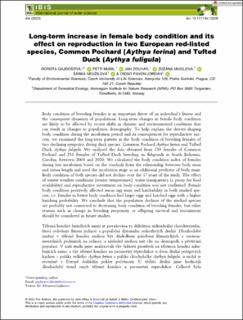| dc.contributor.author | Gajdosova, Dorota | |
| dc.contributor.author | Musil, Petr | |
| dc.contributor.author | Zouhar, Jan | |
| dc.contributor.author | Musilová, Zuzana | |
| dc.contributor.author | Neuzilová, Sárka | |
| dc.contributor.author | Pavon-Jordan, Diego | |
| dc.coverage.spatial | South Bohemia, Czechia | en_US |
| dc.date.accessioned | 2023-09-27T10:40:49Z | |
| dc.date.available | 2023-09-27T10:40:49Z | |
| dc.date.created | 2023-03-17T09:40:20Z | |
| dc.date.issued | 2023 | |
| dc.identifier.issn | 0019-1019 | |
| dc.identifier.uri | https://hdl.handle.net/11250/3092336 | |
| dc.description.abstract | Body condition of breeding females is an important driver of an individual’s fitness and the consequent dynamics of populations. Long-term changes in female body condition are likely to be affected by recent shifts in climatic and environmental conditions that can result in changes to population demography. To help explain the drivers shaping body condition during the incubation period and its consequences for reproductive success, we examined the long-term pattern in the body condition of breeding females of two declining sympatric diving duck species: Common Pochard Aythya ferina and Tufted Duck Aythya fuligula. We analysed the data obtained from 139 females of Common Pochard and 251 females of Tufted Duck breeding on fishponds in South Bohemia, Czechia, between 2004 and 2020. We calculated the body condition index of females during late incubation based on the residuals from the relationship between body mass and tarsus length and used the incubation stage as an additional predictor of body mass. Body condition of both species did not decline over the 17 years of the study. The effect of winter weather conditions (winter temperature), water transparency (a proxy for food availability) and reproductive investment on body condition was not confirmed. Female body condition positively affected mean egg mass and hatchability in both studied species, i.e. females in better body condition laid larger eggs and hatched eggs with a higher hatching probability. We conclude that the population declines of the studied species are probably not connected to decreasing body condition of breeding females, but other reasons such as change in breeding propensity or offspring survival and recruitment should be considered in future studies. | en_US |
| dc.language.iso | eng | en_US |
| dc.relation.uri | https://onlinelibrary.wiley.com/doi/10.1111/ibi.13208 | |
| dc.rights | Navngivelse 4.0 Internasjonal | * |
| dc.rights.uri | http://creativecommons.org/licenses/by/4.0/deed.no | * |
| dc.subject | body condition index | en_US |
| dc.subject | climate change | en_US |
| dc.subject | diving ducks | en_US |
| dc.subject | egg mass | en_US |
| dc.subject | hatchability | en_US |
| dc.title | Long-term increase in female body condition and its effect on reproduction in two European red-listed species, Common Pochard (Aythya ferina) and Tufted Duck (Aythya fuligula) | en_US |
| dc.title.alternative | Long-term increase in female body condition and its effect on reproduction in two European red-listed species, Common Pochard (Aythya ferina) and Tufted Duck (Aythya fuligula) | en_US |
| dc.type | Peer reviewed | en_US |
| dc.type | Journal article | en_US |
| dc.description.version | publishedVersion | en_US |
| dc.rights.holder | © 2023 The Authors | en_US |
| dc.subject.nsi | VDP::Zoologiske og botaniske fag: 480 | en_US |
| dc.subject.nsi | VDP::Zoology and botany: 480 | en_US |
| dc.source.pagenumber | 1217-1234 | en_US |
| dc.source.volume | 165 | en_US |
| dc.source.journal | IBIS | en_US |
| dc.identifier.doi | 10.1111/ibi.13208 | |
| dc.identifier.cristin | 2134654 | |
| dc.relation.project | Andre: Technology Agency of the Czech Republic SS01010280 | en_US |
| cristin.ispublished | true | |
| cristin.fulltext | original | |
| cristin.qualitycode | 1 | |

